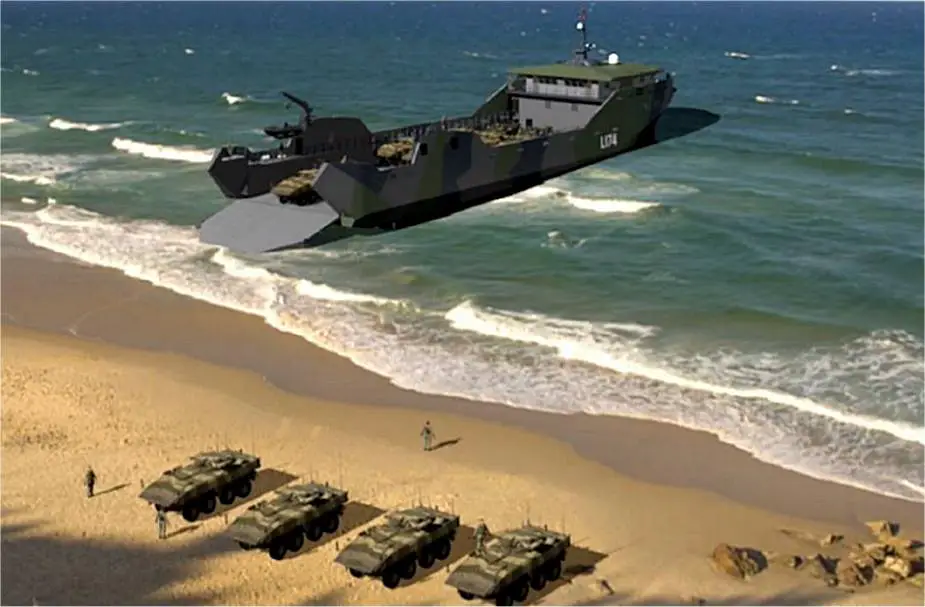Review about new US Navy Light Amphibious Warship LAW for Marines Corps
According to a report of the United States Congress by Ronald O'Rourke, Navy Recognition editorial presents a summary and review about the U.S. Navy Light Amphibious Warship (LAW) for U.S. Marine Corp. The U.S. Navy’s new Light Amphibious Warship (LAW) program envisions procuring a class of 28 to 30 new amphibious ships to support the Marine Corps, particularly in implementing a new Marine Corps operational concept called Expeditionary Advanced Base Operations (EABO).
Follow Navy Recognition on Google News at this link
 Artist rendering of the concept of U.S. Navy Light Amphibious Warship (LAW) for U.S. Marine Corp.(Picture source Sea Transport Solutions, a naval architecture, consulting, surveying, and project-management firm.)
Artist rendering of the concept of U.S. Navy Light Amphibious Warship (LAW) for U.S. Marine Corp.(Picture source Sea Transport Solutions, a naval architecture, consulting, surveying, and project-management firm.)
The EABO (Expeditionary Advanced Base Operations) concept was developed with an eye toward potential conflict scenarios with China in the Western Pacific. Under the concept, the Marine Corps envisions, among other things, having reinforced-platoon-sized Marine Corps units maneuver around the theater, moving from island to island, to fire anti-ship cruise missiles (ASCMs) and perform other missions so as to contribute, alongside Navy and other U.S. military forces, to U.S. operations to counter and deny sea control to Chinese forces. The LAW ships would be instrumental to these operations, with LAWs embarking, transporting, landing, and subsequently reembarking these small Marine Corps units.
The primary function of Navy amphibious ships is to lift (i.e., transport) embarked U.S. Marines and their weapons, equipment, and supplies to distant operating areas, and enable Marines to conduct expeditionary operations ashore in those areas. Although amphibious ships can be used to support Marine landings against opposing military forces, they are also used for operations in permissive or benign situations where there are no opposing forces. Due to their large storage spaces and their ability to use helicopters and landing craft to transfer people, equipment, and supplies from ship to shore without the need for port facilities, amphibious ships are potentially useful for a range of combat and non-combat operations.
In October 2020, the U.S. Navy issued a Request For Information (RFI) for the preliminary design (PD) for the Light Amphibious Warship (LAW), revealing more specifications for the ship. The new ship will be able to embark up to 75 U.S. Marines and will have 4,000 to 8,000 square feet of cargo area for the Marines’ weapons, equipment, and supplies.
The ship will be able to reach a transit speed of at least 14 knots, and preferably 15 knots with a minimum unrefueled transit range of 3,500 nautical miles. One of the main mandatory features of the new ship, a stern or bow landing ramp must be available for moving the Marines and their weapons, equipment, and supplies the ship to shore (and vice versa) across a beach. She should also be equipped with a modest suite of C4I (Command, Control, Communications, Computers, & Intelligence) equipment. Armament of the ship will include a 25mm or 30mm gun system and .50 caliber machine guns for self-defense.
The LAW’s (Light Amphibious Warship) maximum draft of 12 feet is intended to permit the ship to transit shallow waters on its way to and from landing beaches. The Navy prefers that the ship’s cargo space be in the form of open deck storage. Unlike most of the Navy’s current amphibious ships, the LAW would not have a well deck.
A transit speed of about 15 knots would be less than the approximate 22-knot maximum sustained speed of larger U.S. Navy amphibious ships, but it is a relatively fuel-efficient speed for moving ships through water,30 which would permit the ship to be equipped with a less powerful and consequently less expensive propulsion plant. The 20-year expected service life is less than the 30- to 45-year expected service lives of larger U.S. Navy amphibious ships—a difference that could reduce the LAW’s construction cost for a ship of its type and size—and closer to the 25-year expected service life of the Navy’s Littoral Combat Ships (LCSs).


























